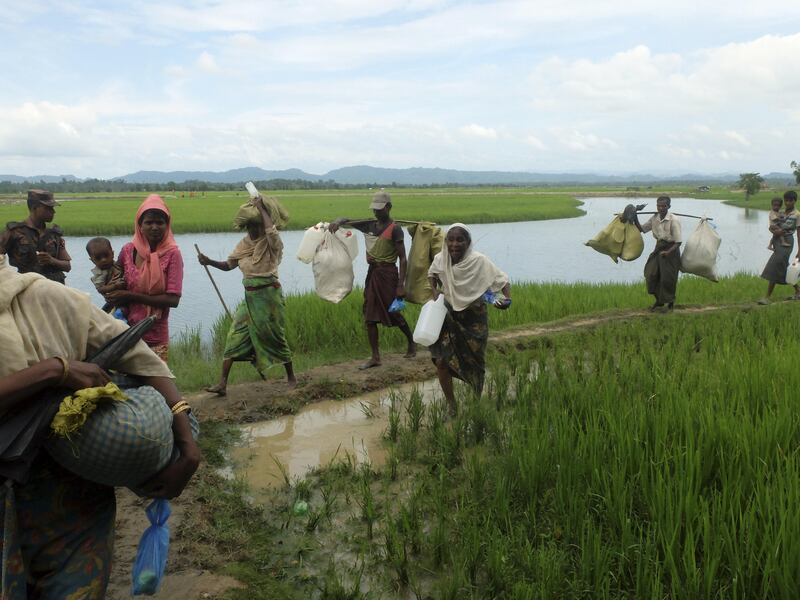The Bangladesh government relented on Thursday and allowed thousands of exhausted and hungry Rohingya to reach the relative safety of the country’s refugee camps after holding them at the border for four nights.
Most of those who spoke to The National at the Anjuma Para border crossing point said their own homes or their neighbours' homes in Myanmar's northern Rakhine state had been burnt by the military or Buddhist neighbours. Several told how relatives or friends had been killed in reprisal attacks that followed deadly assaults on Myanmar security posts on August 25 by the Arakan Rohingya Salvation Army militant group.
Numerous new arrivals described how, even if they had not experienced direct violence themselves, they had been frightened to witness the burning of neighbouring villages in the past two weeks or had left because the Myanmar military had taken all of their possessions and animals, leaving them unable to feed themselves.
Captain Rubel, the Bangladesh border guard in charge of the Anjuma Para crossing point, told The National on Wednesday the refugees were being held there because they were from the Maungdaw region of northern Rakhine — which lies immediately across the border — and were not coming to flee terrible violence, but to join relatives in the Bangladesh camps for "a better life".
But everyone who spoke to The National said they came from the Buthidaung region, further from the border. Those who said they had left their homes during the worst violence in the immediate aftermath of the August 25 attacks said they had taken shelter for days or weeks in other villages before carrying on to the border.
Captain Rubel, who oversaw the movement of the refugees to the camps on Thursday, explained the authorities' change of heart: “Yesterday some of our high [government] officials came and saw the suffering of these people so we made the decision to let them come even though it is beyond our capabilities [to host them]; otherwise there was a risk people might die.”
He said that close to 7,000 people had passed from the border to the camps on Thursday, but the UN had earlier put the number of refugees waiting there at more than 10,000.
[ Watch: Drone video shows thousands of Rohingya cross river to enter Bangladesh ]
The seemingly endless trail of refugees began to leave their makeshift camp in the border paddy fields at around 9am — but their journey was still not over. All but the very weakest had to make the long trek through more muddy paddy fields and across a small river to reach the sprawling refugee camps where more than 580,000 Rohingya have ended up since August 25. For many, this trek took around five hours as they carried small children and what meagre possessions they had managed to bring with them from Myanmar.
Gul Haras, 70, said she lived in a tiny village which had not been directly attacked by the military. But, in a neighbouring larger village she named as Tum Bazar, she saw the bodies of people who had been locked in a house by the Myanmar military and burnt alive.
Later the military arrived in her own village. “They took everything, everything. Our cows, our chickens, our goats. I saw other places burning. They came often at night. It was so shocking — horrifying,” she said as she waited at an aid distribution centre at the Kuta Palong refugee camp on Thursday afternoon.
“I’ve walked all the way [from the border] since morning. I am so tired and I have a fever,” she said.
It was still unclear on Thursday afternoon where Ms Haras and the other new arrivals would spend the night. Many who reach the camps spend their first days and nights in the open air.
Senora, 17, who waited with her visibly sick mother and five younger siblings for a tuk tuk arranged by aid workers to take them from the border to a medical clinic, said all the houses around her home had been burnt. She described how she had seen the bodies of eight of her relatives — a single family — who had all been killed with bullets or knives.
“All of the violence was so horrible. I have no words to explain,” she said.
She said her family had fled their home about a month ago and taken shelter for just over two weeks in an empty house in another village whose residents had fled, before setting out for the border about two weeks ago.
“We’ve lost our father. I don’t know where he is, but I heard he had been killed,” she said.
Arunn Jegan, project coordinator with Medecins Sans Frontieres, who was overseeing treatment of the refugees at a makeshift clinic on the border, said that while the new arrivals did not show signs of having violent injuries it was “clearly a population fleeing violence”.
Many of those making their way to camps showed clear signs of trauma, and others described the misery of waiting for four nights at the border — some without even polythene to shelter under — and hearing gun shots from the Myanmar side.
The Bangladesh government has been widely praised for its response in taking in almost 600,000 refugees in less than two months. But the reluctance to allow in these latest arrivals suggests patience may be growing thin.
More than half of Myanmar’s mainly-stateless Rohingya Muslims have fled over the border since August 25. Despite the efforts of the Bangladesh government and numerous international and local aid agencies, conditions in the camps remain dire and health experts say a major disease crisis is imminent unless there are immediate improvements.
________________________
Read more:
[ Sheikh Mohammed bin Rashid orders more relief for Rohingya ]
[ One killed as Yangon blaze guts historic teak wood hotel ]
________________________





